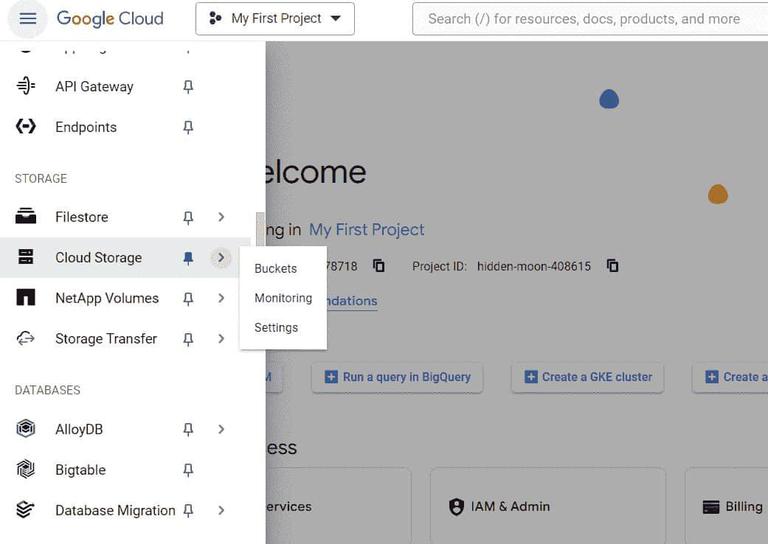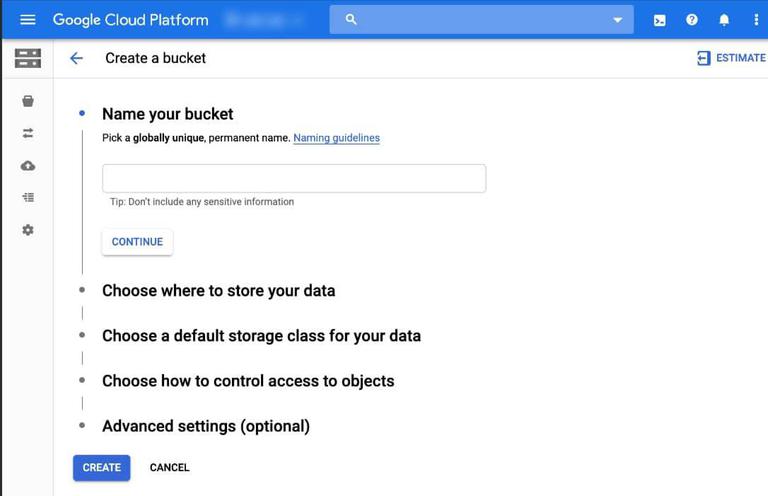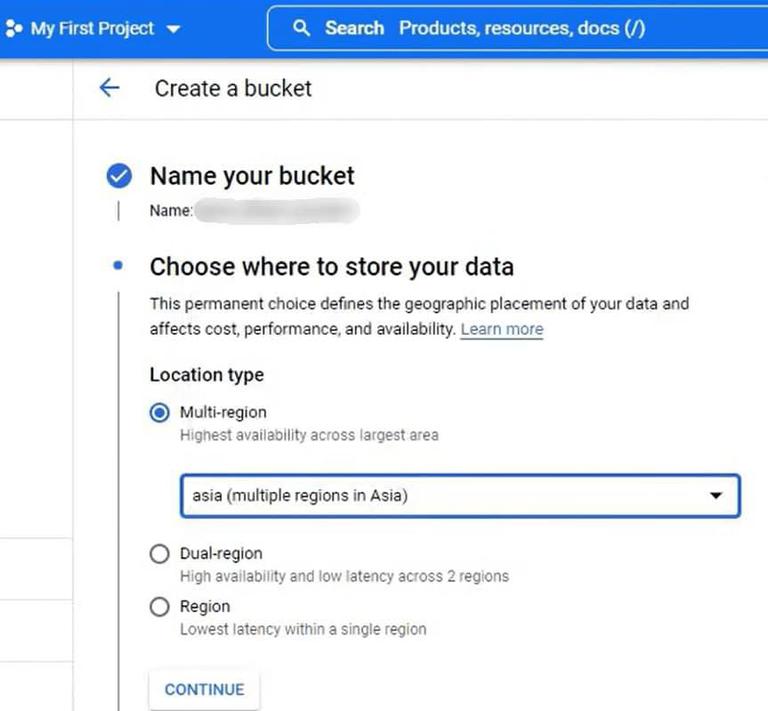How To Create Cloud Storage Buckets In GCP ?
Last Updated :
26 Feb, 2024
It is becoming very important to protect and secure our data since more threats and attacks can be seen nowadays. Cyberattacks and data breaches are very common, and it is very difficult to track them. Some cases of attacks also go unreported and undetected. Before facing such attacks and threats online, we should be informed about these online attacks, malware injection, phishing, and data breaches. When we store our data on the internet, it looks safe to us, but it is not secure enough to be protected from attackers and hackers. Google Cloud provides a solution to this by giving full security to your stored data. You can store your data on Google Cloud, and it will protect you from any attacks and data breaches by applying layers of protection and encryption.
What is Google Cloud?
Google Cloud is a cloud-based, global network of data centers that provides a variety of cloud-based solutions to help users and companies store and manage data, deploy web applications, and build scalable networks. The data centers of Google Cloud are spread all over the world, especially in Asia, Europe, and America regions which are maintained with high security and encryption. There are different zones within its data centers to store data, and in case of any damage to one region will not affect the other regions, especially in case of natural disaster. The zones are connected to provide easy communication, high speed, and seamless operation between two centers. Cloud data helps to replicate data across multiple zones within a region so that it can easily back up the data in case of any damage. Google Cloud allows worldwide storage service and easy retrieval of data. It is a cost-effective and environmentally friendly solution to store your data online and protect it from any attacks. Further, in this article, we will see how we can create a bucket, the benefits of using GCP, and its advantages and disadvantages.
Benefits Of Using Google Cloud
- User friendly
- Data backups and recovery
- Security and encryption
- Community support
- Security
- Cost-effective.
Different Cloud Storage Services by Google Cloud
- Cloud Storage (object storage)
- Google Persistent (block storage)
- Cloud Bigtable
- Cloud Spanner
- Google Cloud Firestore (network file storage)
- Cloud Filestore
- Cloud SQL
Why Do We Create Bucket in Google Cloud?
By creating bucket, you can store your data in cloud, organize your data and control access to your data which means you can set permission on your data by allow who can access, read and manage your data to add one more layer of security. There is no limit to the number of buckets you can create in Cloud. The buckets are uniquely named and given a geographic location where they are stored. These bucket’s name and location once created cannot be changed but you can move the data of one bucket into another by creating a similar bucket of a different name. The pricing of the storage in Google cloud depends upon the bucket’s location and storage class and from region to region. The price in south America may differ from price in south America and it may be different for Asia and Europe. The price of the service is subject to change over time, for more details you can visit Google Cloud Pricing. The table gives the detailed overview of pricing in the Asia region:
|
Location
|
standard storage
(per GB per month)
|
Nearline storage
(per GB per month)
|
Coldline storage
(per GB per month)
|
Archive storage
(per GB per month)
|
|
Tiwan(asia-east1)
|
$0.020
|
$0.010
|
$0.005
|
$0.0015
|
|
Hong Kong(asia-east2)
|
$0.023
|
$0.016
|
$0.007
|
$0.0025
|
|
Tokyo(asia-northeast1)
|
$0.023
|
$0.016
|
$$0.006
|
$0.0025
|
|
Osaka(asia-northeast2)
|
$0.023
|
$0.016
|
$$0.006
|
$0.0025
|
|
Seoul(asia-northeast3)
|
$0.023
|
$0.016
|
$$0.006
|
$0.0025
|
|
Mumbai(asia-south)
|
$0.023
|
$0.016
|
$$0.006
|
$0.0025
|
|
Delhi(asia-south1)
|
$0.023
|
$0.016
|
$$0.006
|
$0.0025
|
|
Singapore(asia-southwast1)
|
$0.020
|
$0.010
|
$0.005
|
$0.0015
|
In India, Google cloud has two regions:
|
India
|
|
|
ASIA-SOUTH1
|
MUMBAI
|
|
ASIA-SOUTH2
|
DELHI
|
Naming Convention For Buckets
- You cannot create a bucket with a name which already exist in gcp. If you will try to create a bucket with a name which has already existed, then it will show error.
- Your name should not contain any important or personal details. Since the name is publicly visible, the Id’s, email address and other identifiable information should not be included in the bucket’s name.
- You cannot immediately use the name of a bucket which is deleted recently. The name is available only after some few weeks or days.
- The bucket names can only contain lowercase, dases (-), dots (.), underscores and numeric characters. Names which contain dots needs special verification form gcp.
- Space is not allowed in between two words while naming. For example (data bucket.11).
- The bucket name should start and end with a number or a letter. You cannot use underscore or dots at the start and at the end.
- You can use some of the google clouds key word like “goog”, “g00gle” or such misspelling similar words.
- Bucket names cannot be represented as an IP address in dotted-decimal notation. For example (121.212.21.13).
- The names must contain only 3 to 63 characters and the names with dots can contain up to 222 characters. But each dot-separated component can be no longer than 63 characters.
|
Names which are valid
|
Names which are not valid
|
- ok-bucket-ok
- 11sdf-sds11-ds
- fa.sfa.ssd.s
|
- dy -sd-Ssdf(It contains upper case)
- more_google( It contains gooogle word)
- szsd fdssd( Contains space)
|
How to create cloud storage buckets in gcp
Step 1: Go to Google Clouds console
Our first step is visit google cloud console https://console.cloud.google.com/. The link will direct you to google cloud’s page where you can see different options and service provided by Google Cloud. If you want to see the projects and buckets created, you can just click on cloud storage to see all you created projects under cloud storage .

Google Cloud Console
Click on left side navigation tab or the three-line tab. Then scroll down and find cloud storage tab. After clicking on cloud storage, you will be able to see three options. Just click on bucket. Then click on “Create Bucket”.

Google Cloud’s Menu
Step 2: Configure our bucket
To name our bucket we must follow the guidelines given by Google in its documentation. The important naming conventions to name the bucket is already mentioned in the article. After naming the bucket we have to choose the storage class. Gcp offers four types of storage class to choose from, they are:
- Multi-Regional
- Regional
- Nearline
- Coldline
Each have its own advantage and disadvantage. They storage class are made based on diiferent factors such as how frequent you access your data, data recovery, speed and latency. Every class has its own features, and they have different pricing.

Naming The Bucket
Choose where to store your data:

Choose where to store your data
You can select the storage class from these available options.

Choose the storage class for your data
Access Control helps to set permissions, which determines that who can access the files in the bucket and up to what level one can access those files.

Access control
By choosing how to protect object data will help in data recovery and data protection.
 You can also add data encryption further for your data to give one more layer of protection.
You can also add data encryption further for your data to give one more layer of protection.
 The bucket will be created once you have selected all the necessary options. You can see the bucket in the object section which can be accessed directly by clicking on cloud storage option.
The bucket will be created once you have selected all the necessary options. You can see the bucket in the object section which can be accessed directly by clicking on cloud storage option.

Conclusion
Google cloud is among the most preferred storage option to store data online since it is supported by Google’s vast community support and trust. The security provided by Google is top notch and at cost effective value which makes it a good option to consider it to store your data. You can choose the best storage service by looking its features and price. Every storage class has its own unique feature and pricing to choose from. We can choose the storage class that best fits your needs based on factors such as cost, duration, Latency, time period, how frequent we access the data and etc.
How to create cloud storage buckets in gcp – FAQ’s
Why do we create bucket in Gcp?
Buckets are used to store your data in google cloud. They can store images, audio, videos and etc. The data stored in bucket is organized can be accessed easily.
Is it safe to store data in bucket?
Yes, it is completely safe to store your data in a bucket. You can also add your encryption or password in it.
Can I create two buckets with a same name?
No, you cannot create two buckets with a same name. Every bucket created inside gcp shoud be unique.
Can we create a bucket inside a bucket?
No, we cannot create a bucket inside a bucket.
Share your thoughts in the comments
Please Login to comment...